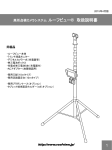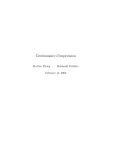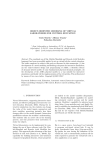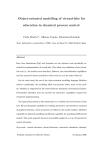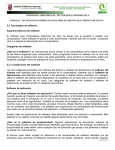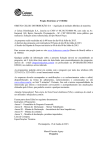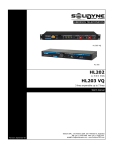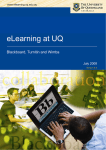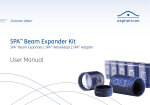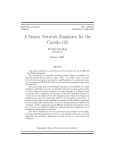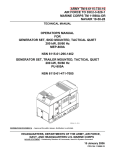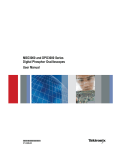Download An approach to virtual-lab implementation using Modelica
Transcript
May 4, 2007 9:44 Mathematical and Computer Modelling of Dynamical Systems VirtualLabBuilder Mathematical and Computer Modelling of Dynamical Systems Vol. 00, No. 00, January 2006, 1–21 An approach to virtual-lab implementation using Modelica CARLA MARTIN-VILLALBA∗ , ALFONSO URQUIA and SEBASTIAN DORMIDO Departamento de Informática y Automática, UNED Juan del Rosal 16, 28040 Madrid, Spain A novel approach to the implementation of interactive virtual-labs is proposed. The virtual-lab is completely described in Modelica language and translated using Dymola. To achieve this goal, a systematic methodology to transform any Modelica model into a formulation suitable for interactive simulation has been developed. In addition, VirtualLabBuilder Modelica library has been programmed. This library contains a set of Modelica models of visual interactive elements (i.e., containers, animated geometric shapes and interactive controls) that allows easy creation of the virtual-lab view (i.e., the model-to-user interface). This approach has two strong points. Firstly, it allows taking advantage of the Modelica capabilities for multi-domain modelling and model reuse. In particular, existing Modelica libraries for modelling of physical systems can be reused in order to build the virtual-lab models. Secondly, VirtualLabBuilder library allows describing the virtual-lab view with Modelica, which facilitates its development, maintenance and reuse. The proposed approach is discussed in this manuscript and it is illustrated by means of two case studies: a virtual-lab of an industrial boiler and a virtual-lab describing the thermodynamic behaviour of a solar house. Keywords: Modelica; Virtual laboratory; Control education; Interactive simulation; Simulation animation AMS Subject Classification: 97U04; 93A04; 93C04 1. Introduction A virtual-lab is a distributed environment of simulation and animation tools, intended to perform the interactive simulation of a mathematical model. Virtual-labs supporting interactive simulations are effective educational resources [1]. During the interactive simulation run, students can change the value of some selected inputs, parameters and state variables of the model, perceiving instantly how these changes affect the model dynamic. An arbitrary number of actions can be made on the model during a given simulation run. Virtual-labs allow students to play an active role in their learning process and this promotes their motivation to study the subject. Virtual-labs are composed of introduction, model and view. The introduction is the documentation (frequently a set of html pages) discussing the concepts and phenomena illustrated by the virtual-lab, how to experiment with the lab, and also proposing some activities or exercises [2]. The model is the mathematical model representing the relevant behaviour of the system under study. The view is the user-to-model interface. It is intended to provide a visual representation of the simulated model behaviour and to facilitate the user’s interactive actions on the model during the simulation run. The graphical properties of the view elements are linked to the model variables, producing a bi-directional flow of information between the view and the model. Any change of a model variable value is automatically displayed by the view. Reciprocally, any user interaction with the view automatically modifies the value of the corresponding model variable. There are many software tools specifically intended to facilitate the implementation of virtual-labs. Two of them are Easy Java Simulations [3, 4] and Sysquake [5]. The strong point of these tools is that they allow easy creation of the virtual-lab view. Their weak point is the model definition, that requires explicit state models (ODE). This restriction strongly conditions the modelling task, which requires a considerable effort from the virtual-lab developer. Modelica [6] is a freely available, object-oriented modelling language that supports the physical modelling paradigm [7]. Models are mathematically described by differential and algebraic equations (DAE), and discrete equations. Modelica supports a declarative (i.e., non-causal) description of the model. Therefore, ∗ Corresponding author. Email: [email protected] Mathematical and Computer Modelling of Dynamical Systems c 2006 Taylor & Francis ISSN: 1387-3954 print/ISSN 1744-5051 online http://www.tandf.co.uk/journals DOI: 10.1080/1387395YYxxxxxxxx May 4, 2007 9:44 2 Mathematical and Computer Modelling of Dynamical Systems VirtualLabBuilder C. Martin-Villalba, A. Urquia and S. Dormido the use of Modelica reduces considerably the modelling effort and permits better reuse of the models. In addition, a number of free and commercial Modelica libraries in different domains are available [6], including electrical, mechanical, thermo-fluid and physical-chemical. However, neither Modelica language nor Modelica simulation environments (i.e., Dymola [8], OpenModelica [9], etc.) support interactive simulation. As a consequence, extending Modelica capabilities in order to facilitate interactive simulation (i.e., virtual-lab implementation) is an open research field [10–13]. Previous work on this topic addresses the combined use of Modelica/Dymola and other software tools [11–13]: the virtual-lab model is described using Modelica and the virtual-lab view is implemented using software tools suited for building interactive user interfaces. In particular, the combined use of Modelica/Dymola, Matlab and Easy Java Simulations is proposed in [11–13]; and the combined use of Modelica/Dymola and Sysquake is proposed in [12]. 1.1. Contributions of this paper The goal of the work discussed in this manuscript is to facilitate the description of virtual-labs using Modelica language. To achieve this goal, the following two tasks have been completed [14]: (i) A systematic methodology to transform any Modelica model into a formulation suitable for interactive simulation has been proposed. Modelica models adapted according to this methodology can be used to set up interactive virtual-labs. (ii) VirtualLabBuilder Modelica library has been designed and programmed. It includes Modelica models implementing graphic interactive elements, such as containers, animated geometric shapes and interactive controls. These models allow the virtual-lab developer: (1) to compose the view; and (2) to link the visual properties of the virtual-lab view with the model variables. The interactive graphic interface is automatically generated during the model initialization process. The components of the library contain the code required to perform the bidirectional communication between the view and the model. In addition, VirtualLabBuilder library supports including in the virtual-lab an introductory part, which is composed of html pages. An overview of the proposed approach to virtual-lab implementation using Modelica is provided in section 2. The methodology to transform any Modelica model into a formulation suitable for interactive simulation is discussed in section 3. The architecture and use of VirtualLabBuilder library is described in section 4. Finally, the application of the proposed approach is illustrated by means of two case studies: (1) the implementation of a virtual-lab intended to illustrate the automatic control of an industrial boiler (section 5); and (2) the implementation of a virtual-lab describing the thermodynamic behaviour of a solar house (section 6). 2. Overview of the proposed approach The virtual-lab definition includes the description of the introduction, the model, the view, and the bidirectional flow of information between the model and the view. Next, the virtual-lab definition process is outlined. (i) Virtual-lab model. Any Modelica model can be transformed into other Modelica model suitable for interactive simulation. A systematic methodology to perform this transformation is proposed in section 3. Essentially, it consists in modifying the model so that all the variables that need to be changed interactively during the simulation (i.e., the interactive variables) are formulated as state variables. In particular, parameters are redefined as time-dependent variables whose time-derivative is equal to zero. Input variables are reformulated analogously in order to become interactive variables. Modelica’s when clause and reinit operator allow describing instantaneous changes in the value of the state variables. This feature is exploited in order to perform the instantaneous changes in the value of the interactive variables produced by the user’s interaction. Some of these model manipulations could May 4, 2007 9:44 Mathematical and Computer Modelling of Dynamical Systems VirtualLabBuilder An approach to virtual-lab implementation using Modelica 3 b) a) c) d) Figure 1. VirtualLabBuilder library: a) General structure; and Classes within the following packages: b) InteractiveControls; c) Drawables; and d) Containers. (ii) (iii) (iv) (v) be performed automatically by a software tool. However, at the present time, they have to be carried out manually by the virtual-lab developer. Virtual-lab view. The virtual-lab developer has to define a Modelica class describing the virtual-lab view. This class has to extend another class, named PartialView, that is included in VirtualLabBuilder library (see figure 1a). PartialView class contains a pre-defined component: the root element for the view description. The classes describing the graphic components are within the InteractiveControls, Drawables and Containers packages of VirtualLabBuilder library (see figures 1b, 1c and 1d respectively). The virtuallab designer has to compose the virtual-lab view class by instantiating and connecting the required graphic components. The graphic components have to be connected forming a structure, whose root is the root element. The connections among the graphic components determines their layout in the virtual-lab view. VirtualLabBuilder’s graphic components and their connection rules are discussed in section 4. Virtual-lab set up. The virtual-lab developer has to define a Modelica class describing the complete virtual-lab. This class has to extend the VirtualLab class, which is within the VirtualLabBuilder library (see figure 1a). VirtualLab class has two parameters: the class describing the virtual-lab model, and the class describing the virtual-lab view. These two classes have been programmed in Steps (i) and (ii) respectively. The virtual-lab designer has to set the value of these parameters by writing the name of these two classes. In addition, he has to specify how the variables of the model and the view Modelica classes are linked. This is accomplished by writing the required Modelica equations inside the Modelica class defining the complete virtual-lab. Virtual-lab translation and execution. The virtual-lab developer needs to translate using Dymola [8] an instance of the Modelica class defined in Step (iii) into an executable file (i.e., dymosim.exe file). The virtual-lab is started by executing this file. Automatic code generation and run. At the beginning of the simulation run, some calculations are performed in order to solve the model at the initial time. The initial sections of the Modelica model describing the virtual-lab are evaluated. In particular, the initial sections of the interactive graphic objects composing the virtual-lab view class and of the PartialView class are executed. These initial sections contain calls to Modelica functions, which encapsulate calls to external C-functions. These May 4, 2007 9:44 Mathematical and Computer Modelling of Dynamical Systems 4 VirtualLabBuilder C. Martin-Villalba, A. Urquia and S. Dormido = − = = = Figure 2. Model used to illustrate the translation from the physical model to the interactive model. C-functions are Java-code generators. As a result, during the model initialization, the Java code of the virtual-lab view is automatically generated, compiled, packed into a jar file and executed. Also, the communication procedure between the model and the view is automatically set up. This communication is based on a client-server architecture: the C-program generated by Dymola [8] (i.e., dymosim.exe, see Step (iv)) is the server and the Java program (which has been automatically generated during the model initialization) is the client. Once the jar file is executed, the initial layout of the virtual-lab view is displayed and the client-server communication is established. Then, the model simulation starts. During the simulation run, there is a bi-directional flow of information between the model and the view. 3. Model description for interactive simulation using Modelica language A methodology for transforming any Modelica model into a description suitable for interactive simulation is proposed in this section. The following terminology will be used. The original model of the system is called physical model, and its reformulation for interactive simulation is called interactive model. The model shown in figure 2 will be used to illustrate the discussion. The voltage applied to the pump (v) is an input variable (i.e., its value is not calculated from the model equations). The cross-sections of the tank (A) and the outlet hole (a), the pump parameter (k) and the gravitational acceleration (g) are parameters (i.e., time-independent magnitudes of the model). The liquid volume (V ), the input and output flows (Fin , F ), and the liquid level (h) are time-dependent variables of the physical model. 3.1. Interactive magnitudes The virtual-lab design process includes selecting the interactive magnitudes. These are the model magnitudes whose value will be interactively changed by the user during the simulation run. The virtual-lab goal is illustrating the dependence between the model dynamic behaviour and the value of these magnitudes. Interactive magnitudes can be parameters, input variables, and time-dependent variables of the physical model. For instance, some interactive magnitudes of the model shown in figure 2 could be the following: – Parameters: the cross-sections of the tank (A) and the outlet hole (a), and the pump parameter (k). – Time-dependent variables: the liquid level (h). – Input variables: the voltage applied to the pump (v). The interactive model combines the dynamic behaviour described in the physical model and the abrupt changes in the value of the interactive magnitudes produced by the user’s actions: (i) The evolution in time of the interactive time-dependent magnitudes is described by the physical model equations. In addition, their value can change abruptly as a result of the user’s interaction. (ii) The value of the interactive model parameters can be abruptly changed by the user’s action, remaining constant between consecutive interactive changes. (iii) The value of the interactive input variables is interactively set by the user. Their values change abruptly as a result of the user’s action, remaining constant between consecutive changes. May 4, 2007 9:44 Mathematical and Computer Modelling of Dynamical Systems VirtualLabBuilder An approach to virtual-lab implementation using Modelica 5 Parameters represent time-independent magnitudes. Input variables represent boundary conditions which are not calculated from the model equations. Although they are conceptually different, the dynamic behaviour of interactive parameters and interactive input variables is the same. Their values change abruptly at the interaction instants, remaining constant between consecutive changes. As a consequence, both types of interactive magnitudes are described in the same manner in the interactive model. 3.2. Description of the interactive magnitudes In order to support abrupt changes in their values during the simulation run, interactive magnitudes need to be state variables of the interactive model. The interactive model is obtained from the physical model by reformulating (when required) the declaration and evaluation of the interactive magnitudes, so that they become state variables of the interactive model. To this end, the virtual-lab developer has to perform the following tasks. – Time-dependent variables need to be selected as state variables. Modelica 2.0 and Dymola support the user’s control on the state variables selection, via the stateSelect attribute of Real variables [8,15–17]. This attribute values include “never” (the variable will never be selected as state variable) and “always” (the variable will always be used as a state). This feature allows the user to select the model state variables without performing any manipulation on the model equations. The required model manipulations are automatically performed by Dymola. – Parameters and input variables are redefined as time-dependent variables with zero time-derivative, and they are selected as state variables. For instance, the parameter A of the tank model shown in figure 2 should be a Real variable of the interactive model, calculated from the equation der(A) = 0. model tank parameter Real Ainitial Real A (start = Ainitial) ... equation der(A) = 0; ... end tank; "Initial value of the tank section"; "Tank section - Interactive magnitude"; Let’s consider that all the interactive magnitudes can be simultaneously selected as state variables (this condition will be removed in section 3.3). Provided that this restriction is satisfied, the virtual-lab developer does not need to perform further modifications in the model. In particular, the required code to implement the user’s changes in the value of the interactive magnitudes is pre-defined in the interactive control elements (shown in figure 1b). Changes in the model state are performed as state re-initialization events by using the Modelica’s reinit(x, expr) operator. It re-initializes an state variable (x) with the value obtained by evaluating an expression (expr), at the event instant. These changes are triggered using when clauses. Defining the interactive parameters and input variables as state variables increases the number of state variables. This has an unwanted effect: it slows down the simulation. We could think of redefining the interactive parameters and input variables as discrete-time variables or, alternatively, as input variables whose values are provided by the virtual-lab view. In this way, the number of state variables would not be increased. However, this is not a valid approach. Dymola automatically performs model manipulations in order to formulate the model according to the requested state selection. The problem is that these model manipulations can require differentiating an interactive parameter or input variable, which results in an error being generated. An example is discussed next. Consider the model shown in figure 2. It is formulated according to the state selection e1 = {V }. The model can be manipulated as shown below, in order for h to be a state variable instead of V . The variable to evaluate from each equation is written within square brackets. p [F ] = a 2gh (1) May 4, 2007 9:44 6 Mathematical and Computer Modelling of Dynamical Systems VirtualLabBuilder C. Martin-Villalba, A. Urquia and S. Dormido [Fin ] = kv (2) [derV ] = Fin − F (3) [V ] = Ah (4) h i derV = Ȧh + A ḣ (5) The time-derivative of the tank cross-section (i.e., Ȧ) appears in Eq. (5). If the interactive magnitude A is defined as an input variable, then an error is produced: Dymola can not differentiate an input variable. The same problem arises if A is defined as a discrete-time variable. A valid approach is the previously discussed: defining the interactive parameters and input variables as constant state variables (i.e., Ȧ = 0). The interactive changes in the value of these magnitudes are implemented by re-initializing their values. 3.3. Supporting multiple selections of the state variables In general, different choices of the state variables are possible. For instance, possible choices in the model shown in figure 2 include: e1 = {h} e2 = {V } e3 = {F } where ei represents one particular choice of the state variables. The state variable selection should be made so that it includes all the interactive magnitudes. For instance, if the user wants to change interactively the level value (h), the appropriate choice is e1 = {h}. Likewise, if the user wants to change the liquid volume, then the right choice is e2 = {V }; and if he wants to change the output flow, then e3 = {F }. In addition, changes in the value of interactive parameters can have different effects depending on the state variable choice. Consider a change in the cross-section (A) of the model in figure 2 (for instance, the user interactively changes A from 1 cm2 to 3 cm2 ). If the volume (V ) is a state variable, then the change in A produces an abrupt change in the value of the liquid level (h) and flow (F ), while the liquid volume remains constant. On the contrary, if the state variable is the height (h) or the flow (F ), these magnitude values would not change as the result of an instantaneous change in A but the volume would. In some cases, all interactive magnitudes can be selected as state variables. Then, the description of the interactive model, as it was proposed in section 3.2, is straightforward. However, this is not always the case. Consider, for instance, a virtual-lab illustrating the dynamic behaviour of the model shown in figure 2. This virtual-lab is required to support two ways of describing the interactive changes in the amount of liquid contained in the tank: changes in the liquid volume (V ) and changes in the liquid level (h). Each time the user needs to change the amount of liquid, he can choose between describing it in terms of the volume or in terms of the level. Different choices are possible during a given simulation run. However, V and h can not be simultaneously selected as state variables. An approach to allow interactive models supporting simultaneously different choices of the state variables is the following. Modelling the interactive model as composed of several instantiations of the physical model, each one with a different choice of the state variables. Modelica capability for state selection control (i.e., stateSelect attribute) allows the virtual-lab developer to select the state variables without performing any model manipulation. Therefore, the interactive model is composed of as many instantiations of the physical model as different state selections are required. The adequate physical-model instantiation (i.e., that with the required state selection) is used for executing each interactive action from the user. That is to say, for performing the abrupt changes in the value of the interactive magnitudes and for solving the re-start problem. Next, these calculated values are used to re-initialize the other physical-model instantiations. This action guarantees that all physical-model instantiations describe the same trajectory. This procedure is briefly discussed next. (i) The physical model has to be modified as it was described in section 3.2. In case of the model shown in figure 2, the physical model could be composed of the connection of three components: (1) the May 4, 2007 9:44 Mathematical and Computer Modelling of Dynamical Systems VirtualLabBuilder An approach to virtual-lab implementation using Modelica 7 pump, modelling the input flow of liquid (Fin = kv); (2) the tank, describing the conservation of the liquid volume (dV /dt = Fin − F ) and the relationship between the volume √ and the level of the liquid (V = Ah); and (3) the pipe, describing the output flow of liquid (F = a 2gh). This physical model could be modified as it is shown next. It is supposed that three selections of the state variables are required: e1 = {h}, e2 = {V } and e3 = {F }. model tank parameter Boolean hIsState = false; parameter Boolean VIsState = false; Real h (stateSelect = if hIsState then StateSelect.always else StateSelect.never) "Liquid level"; Real V (stateSelect = if VIsState then StateSelect.always else StateSelect.never) "Liquid volume"; parameter Real Ainitial "Initial value of the tank section"; Real A (start = Ainitial) "Tank section - Interactive magnitude"; ... equation der(A) = 0; ... end tank; model pipe Real F (stateSelect = if FIsState then StateSelect.always else StateSelect.never) "Liquid flow"; parameter Real aInitial = 1 "Initial value of the pipe section"; Real a (start = aInitial) "Pipe section - Interactive magnitude"; ... equation der(a) = 0; ... end pipe; model pump parameter Real vInitial Real v (start = vInitial) parameter Real kInitial Real k (start = kInitial) ... equation der(v) = 0; der(k) = 0; ... end pump; "Initial value of the applied voltage"; "Voltage applied to the pump - Interactive"; "Initial value of the pump parameter"; "Pump parameter - Interactive magnitude"; partial model physicalModel parameter Boolean[3] isState; tank tank1 ( hIsState = isState[1], VIsState = isState[2], ...); pipe pipe1 ( FIsState = isState[3], ...); pump pump1 ( ... ); ... end physicalModel; The boolean vector isState[:], declared in physicalModel, allows controlling the state selection. The size of this vector is equal to the number of interactive time-dependent magnitudes. For instance, if isState[:] is set to the value {false,true,false} when instantiating the physical model, then the liquid volume (V ) is selected as a state variable. Also, the interactive parameters (A, a) and the input variable (v) have been defined as constant state variables. This first step in the implementation of the interactive model is represented in figure 3a. (ii) The setParamVar class is defined (see figure 3b). It inherits from physicalModel, and it contains the May 4, 2007 9:44 Mathematical and Computer Modelling of Dynamical Systems 8 VirtualLabBuilder C. Martin-Villalba, A. Urquia and S. Dormido model interactiveModel model physicalModel StateSelection1 Boolean isState [:] … extends setParamVar ( isState={ … } ) ; I [:] I [:] CK [1:N] CK [1] isState[:] … Enabled [1:N] Enabled [1] CKstate [1:N] CKstate [1] Istate [:] Istate [:] when { CK [1] , Enabled [1] } then reinit ( ivars [:] , I [:] ) ; end when; when { CKstate[1] , Enabled [1] } then reinit ( state1 [:] , Istate ( n11,…,n1M ); end when; O [:] StateSelectionN extends setParamVar ( isState={ … } ) ; I [:] partial model setParamVar isState[:] … I [:] extends physicalModel isState [:] CK [N] … Enabled [N] CK CKstate [N] Enabled when { CK, Enabled } then reinit ( ivars [:] , I [:] ); end when; Istate [:] when { CK [N] , Enabled [N] } then reinit ( ivars [:] , I [:] ) ; end when; when { CKstate [N] , Enabled [N] } then reinit ( stateN [:] , Istate ( nN1,…,nNM ); end when; Enabled [1:N] Figure 3. Schematic description of the proposed modelling methodology for interactive simulation. when-clauses required to change the value of the interactive parameters and input variables. These interactive magnitudes are represented by the ivars[:] array, and their new values, specified interactively by the virtual-lab user, are represented by the I[:] array. The size of these arrays is equal to the number of interactive parameters plus the number of interactive input variables. The when-clauses are triggered by the boolean variables CK and Enabled. When the value of any of these two variables changes from false to true, then the ivars[:] array is re-initialized to the value of the I[:] array. (iii) There are defined as many components (StateSelection1, . . ., StateSelectionN) as different state-variable choices are required (e1 = state1[:], . . ., eN = stateN[:]). The number of state-variable choices to be supported by the virtual-lab is represented by N. The class of these components inherits from setParamVar (see figure 3c). In addition, it contains the when-clauses required to re-initialize its state-variable array (i.e., state array) to the values interactively set by the user (i.e., Istate array). The CK[1:N] and Enabled[1:N] arrays trigger the re-initialization of the interactive parameters and input variables. The CKstate[1:N] and Enabled[1:N] arrays trigger the re-initialization of the interactive time-dependent magnitudes. The i − th component of these arrays controls the i − th instantiation of the physical system (i.e., StateSelectioni). The array Enabled[1:N] indicates which state-variable selection is enabled. It is used to select which output is connected to the output variables (O[:]). These are the variables used to refresh the virtual-lab view. May 4, 2007 9:44 Mathematical and Computer Modelling of Dynamical Systems VirtualLabBuilder An approach to virtual-lab implementation using Modelica 4. 9 VirtualLabBuilder library VirtualLabBuilder library is composed of the packages shown in figure 1a. Some of them are intended to be used by the virtual-lab developers (i.e., VirtualLabBuilder users). These are: (1) ViewElements and VLabModels packages, which contain the classes required to implement the virtual-lab view and to set up the complete virtual-lab; and (2) Examples package, which contains some tutorial material illustrating the library use. The documentation of these packages is oriented to the VirtualLabBuilder users. On the contrary, the classes within the src package are not intended to be directly used by the virtual-lab developers. The documentation of this package describes the implementation details required to modify and extend the VirtualLabBuilder library. In fact, the classes within ViewElements and VLabModels packages inherit from classes defined within src package, inheriting the structure and the behaviour, and adding only the documentation oriented to the virtual-lab developer. VLabModels package contains two classes: PartialView and VirtualLab. The purpose of PartialView and VirtualLab classes was briefly described in section 2. They have to be the super-classes of the models defining the virtual-lab view and the complete virtual-lab respectively. Further details can be found in the VirtualLabBuilder library documentation. ViewElements package is discussed next. 4.1. Interactive graphic elements ViewElements package contains the graphic elements that can be used to define the view. The initial sections of these elements contain calls to Modelica functions that perform calls to external C-functions. These Cfunctions write the Java code of the elements to a file, generating automatically the Java application (i.e., a .jar file) that is the virtual-lab view. The three packages included within ViewElements are briefly described next. A detailed description of these graphic elements and their properties can be found in [14]. – Containers package has those graphic elements that are intended to host other graphic elements. The container properties are set in the view definition and they can not be modified during the simulation run. VirtualLabBuilder contains the following five classes of containers: MainFrame, Dialog, Panel, DrawingPanel and PlottingPanel (see figure 1d). – Drawables package contains several classes implementing interactive 2-D shapes, whose properties (i.e., size, position, rotation angle, aspect ratio, colour, etc.) can be linked to the model variables. They are intended to be used for building animated and interactive schematic representations of the system. These classes are: Polygon, Oval, Text, Arrow and Trail (see figure 1c). Objects of Drawables classes must be placed inside containers that provide a coordinate system (i.e., containers of DrawingPanel and PlottingPanel classes). In addition to this general-purpose interactive components, other domain-specific components can be implemented. In order to demonstrate this capability, Mechanics package has been included within Drawables package. It contains two classes (i.e., Damper and Spring) implementing an interactive damper and an interactive spring. – InteractiveControls package contains classes that allow modifying interactively the value of model variables. These are: Slider, NumberField, RadioButton, Button1Action, Button2Actions, Label and Checkbox. In addition, the PauseButton class creates a button that allows the user to pause and resume the simulation by clicking on it. The InfoButton class creates a button that allows the user to show and hide a window displaying HTML pages. This feature allows including documentation in the virtual-lab. That is to say, it supports the implementation of the virtual-lab introduction. 4.2. Connection rules The interface of the interactive graphic components is composed of connectors, which facilitate the connection among the components. Four connector types have been defined. Each one has a distinctive icon. Connector icons are squared or circular, empty or filled. The following two types of interfaces have been defined (see figures 1b, 1c & 1d): May 4, 2007 9:44 10 Mathematical and Computer Modelling of Dynamical Systems VirtualLabBuilder C. Martin-Villalba, A. Urquia and S. Dormido Figure 4. Tank process: a) Modelica description of the virtual-lab view; and b) virtual-lab. – Interface of container components. It has three connectors (see figure 1d). Two placed on one side (called “left connectors”) and the third one (called “right connector”) placed on the opposite side. – Interface of interactive controls and drawable elements. It has two connectors (called “left connectors”): one filled and one empty (see figures 1b & 1c). The virtual-lab programmer must observe the following three rules when connecting the graphic elements: (i) Only connectors with the same shape (circular or squared) can be connected. (ii) Each filled connector must be connected to one and only one empty connector. (iii) Each empty connector can be left unconnected or can be connected to one and only one filled connector. The meaning of the connections among the graphic components is as follows: – If two components are connected using their “left connectors”, then both components are hosted within the same container. The component position in the chain of connected elements determines its insertion order within the container. – If two components are connected using the “right connector” of the first component and a “left connector” of the second component, then the second component is hosted within the first component. The following example tries to illustrate how the graphic elements can be used to compose the view of a virtual-lab. In particular, the view of the tank process described in section 3. The Modelica description of the virtual-lab view and the obtained virtual-lab are shown in figure 4. In this case, the model of the tank process has only one state selection and one state variable (the liquid level). The mainFrame and dialog components are hosted inside root. The dPanel, panelS and panelN components are hosted inside mainFrame. The C component is hosted inside panelN. The pipe, vase, liqPipe and liquid components are hosted inside dPanel. The a, A, v and h components are hosted inside panelS. The plot component is hosted inside dialog. Finally, the component trail of Trail class is hosted inside plot. The window showing the component parameters is displayed by double clicking on the component icon. The parameter windows of the components trail, a and mainFrame are shown in figures 5a, 5b and 5c respectively. May 4, 2007 9:44 Mathematical and Computer Modelling of Dynamical Systems VirtualLabBuilder An approach to virtual-lab implementation using Modelica a) 11 b) c) Figure 5. Parameter window of the components: a) 5. trail; b) a; and c) mainFrame. Case study I: virtual-lab of an industrial boiler The approach discussed in the previous sections is applied to the implementation of a virtual-lab for control education. This virtual-lab is intended to illustrate the dynamic behaviour of an industrial boiler operating under two different control strategies: manual and decentralized PID. 5.1. Virtual-lab model The mathematical model of the boiler has been extracted from [18]. The input of liquid water is placed at the boiler bottom, and the vapour output valve is placed at the top. The water contained in the boiler is continually heated. The boiler model has been composed using components from JARA 2i [19], a version of JARA library [20, 21] that has been adapted for interactive simulation by applying the methodology proposed in section 3. JARA is a Modelica library of some fundamental physical-chemical principles. JARA’s main application domain is the modelling of transport, thermo-fluid, phase change and chemical processes in the context of automatic control. The model diagram of the boiler and its control system is shown in figure 6. Two control volumes have May 4, 2007 9:44 Mathematical and Computer Modelling of Dynamical Systems 12 VirtualLabBuilder C. Martin-Villalba, A. Urquia and S. Dormido Figure 6. Diagram of the boiler model. been considered: (1) a control volume containing the liquid water stored in the boiler; and (2) a gaseous control volume containing the vapour. The vapour volume is equal to the difference between the boilerrecipient inner volume and the water volume. The boiling is a transport phenomena represented by a model connecting both control volumes. The heat-flow into the boiler, the pressure at the valve output and the water pump are modeled using JARA source models. 5.2. Virtual-lab view The Modelica description of the virtual-lab view is shown in figure 7. It automatically generates the Java code of the interactive graphic interface shown in figure 8. The relationship between the Modelica description and the corresponding graphic interface is briefly explained next. The Modelica model describing the view must extend the PartialView class, which contains one pre-defined graphic element: root. The root component has three components hosted inside it: mainFrame of MainFrame class and dialog and dialog1 of Dialog class. The components mainFrame and dialog generate the two windows shown in figure 8. The mainFrame layout policy is set to BorderLayout, in order to allow selecting the position of the hosted elements (i.e., north, south, centre, east or west positions). In this case, three containers are placed inside mainFrame: drawingPanel (of DrawingPanel class), and panelNorth and panelSouth (of Panel class). – drawingPanel is placed in the centre of the mainFrame. This component contains the animated diagram of the plant. This diagram is composed of drawable elements of Polygon, Oval, Text and Arrow classes. The liquid, heating system, pump and valve are represented by components of Polygon class. The two controllers are represented by components of Oval class and the set-point of the liquid volume is represented by a component of Arrow class. – panelNorth hosts interactive controls of RadioButton, InfoButton, PauseButton and Slider classes. The two radio-buttons allow the user to select the control strategy (manual or decentralized PID). The two sliders allow the user to change the pump input flow and the heater heat-flow when the manual control strategy is selected. The button of the InfoButton and PauseButton classes allows the user, respectively, to pause and resume the simulation and to display a window with the information about the virtual-lab May 4, 2007 9:44 Mathematical and Computer Modelling of Dynamical Systems VirtualLabBuilder An approach to virtual-lab implementation using Modelica Figure 7. Diagram of the Modelica description of the view. Figure 8. View of the boiler virtual-lab. 13 May 4, 2007 9:44 14 Mathematical and Computer Modelling of Dynamical Systems VirtualLabBuilder C. Martin-Villalba, A. Urquia and S. Dormido (see figure 9). – panelSouth hosts interactive controls of Label and Slider classes. These sliders allow the user to perform interactive changes in the value of the boiler volume, the output pressure, the valve opening, the water volume and the vapour flow set points, the mass and temperature of the water, and the vapour moles contained inside the boiler. The dialog container hosts interactive controls of Slider class. These sliders allow the user to change the parameter values of the two PID controllers. The dialog1 container generates the graphic interface shown in figure 10. This container hosts components of PlottingPanel class which contain drawables of Trail class. These drawables generate traces that show the time evolution of some relevant system variables (see figure 10). 5.3. Virtual-lab set up and launch The virtual-lab description is obtained as discussed in section 3. It is translated using Dymola and executed. Then, the jar file containing the Java code of the virtual-lab view is automatically generated and executed. Then, the virtual-lab view is displayed (see figure 8). The dynamic response of the boiler to a step change in the output pressure is shown in figure 10. This change has been interactively performed by the virtual-lab user at the simulated time 243 s. The boiler is operating in automatic control mode. The following four plots are shown in figure 10: (1) the actual value of the vapour flow and its setpoint; (2) the heat generated by the heater; (3) the actual value of the water volume contained inside the boiler, and its setpoint value; and (4) the liquid flow rate generated by the pump. 6. Case study II: virtual-lab of a solar house The implementation of a virtual-lab intended to illustrate the thermodynamics of a solar house is discussed. This virtual-lab allows the user to: (1) change the thermodynamic properties of the slab, the outer and inner walls, and the roof; (2) turn on and off the air conditioning, which is placed in the living room; and (3) set the parameters of the air conditioning control system (i.e., the setpoints for the minimum and maximum values of the temperature). The virtual-lab view contains the floor plan of the house (see figure 13b). The room colours change between blue and red as a function of the temperature inside the room. The heat flow through the outer walls are represented by arrows. The width and orientation of the arrow are functions of the magnitude and the direction of the heat flow, respectively. Also, the virtual-lab view contains plots of some selected magnitudes (see figure 15). 6.1. The Modelica model of the solar house This solar house model is included within the Bondlib library [22]. The model describes the thermodynamic behaviour of an experimental house located near the airport in Tucson, Arizona, with a passive solar heating system. The house has four rooms: two bedrooms, a living room and a solarium that collects heat during the winter and releases it during the summer. The living room has an air conditioning unit. The four rooms are composed using models that describe the outer and inner walls, the roofs, the windows and the slabs. The bond graph technique is used to model the physical laws of heat transfer between the basic components of the house, regarding conduction, convection and radiation. A detailed description of the model can be found in [23, 24]. May 4, 2007 9:44 Mathematical and Computer Modelling of Dynamical Systems VirtualLabBuilder An approach to virtual-lab implementation using Modelica 15 Figure 9. Introduction of the boiler virtual-lab. Figure 10. Time evolution of some selected variables of the boiler virtual-lab. 6.2. Composing the virtual-lab The solar house model has been adapted to suit interactive simulation. Interactive parameters and input variables have been re-defined as constant state variables (i.e., with zero time-derivative). The Modelica description of the virtual-lab view has been developed modularly, by extending and connecting the required graphic components of the VirtualLabBuilder library. Modelica classes have been programmed to describe the view associated to an inner wall (InWallView), an outer wall (ExWallView), a slab (SlabView) and a roof (RoofView). These are described next: – The diagram of the ExWallView Modelica class is shown in figure 11a and the graphic interface gener- May 4, 2007 9:44 Mathematical and Computer Modelling of Dynamical Systems 16 VirtualLabBuilder C. Martin-Villalba, A. Urquia and S. Dormido Figure 11. ExWallView class: a) diagram; and b) generated view. ated is shown in figure 11b. The ExWallView class contains instances of graphic elements contained in VirtualLabBuilder library (i.e., Dialog, DrawinPanel, Panel, Polygon, Text and Slider). The connection among these elements determines the layout of the graphic interface. The graphic interface consists of a window that contains a set of sliders at the bottom and at the top (see figure 11b). These sliders allow the user to modify the temperature and thermodynamic properties of the wall, including the specific thermal conductivity of the dry wall, the thickness of the conduction layer, the specific heat capacity, the density, the thickness of the outer wall, and absorption coefficient. The centre of the window contains a graphical representation of the wall model, which is composed of three conducting layers. – InWallView class contains sliders that allow the user to change the temperature and thermodynamic properties of the wall (i.e., specific thermal conductivity of the dry wall, thickness of the conduction layer, specific heat capacity, density and thickness). – RoofView class contains sliders that allow the user to change the thermodynamic properties (i.e., specific thermal conductivity, thickness, specific heat capacity and density) of the three conducting layers that compose the roof. – SlabView class contains sliders that allow the user to change the slab thermodynamic properties (i.e., May 4, 2007 9:44 Mathematical and Computer Modelling of Dynamical Systems VirtualLabBuilder An approach to virtual-lab implementation using Modelica 17 Figure 12. BedRoom1View class: a) diagram; and b) generated view. specific thermal conductivity, thickness of the slab, specific heat capacity, density and thickness of the conduction layer). Modelica classes have been composed using VirtualLabBuilder to describe the view associated to the house (HouseView), the living room (LivingRoomView), and bedrooms 1 and 2 (BedRoom1View and BedRoom2View). These are briefly described next: – The diagram of the BedRoom1View class is shown in figure 12a, and the generated graphic interface is shown in figure 12b. This model contains instances of SlabView, RoofView, ExWallView and InWallView classes. The view consists of a window that has a set of checkboxes at the bottom and the floor plan of the room at the centre (see figure 12b). The checkboxes allow the user to show and hide the windows associated to each building component of the room (outer and inner walls, slab and roof). – The diagram of the HouseView class is shown in figure 13a, and the generated graphic interface is shown in figure 13b. The view consists of a window that has a set of checkboxes at the bottom and a diagram of the house floor plan in the centre (see figure 13b). The checkboxes allow the user to show and hide the windows associated to the bedrooms 1 and 2, and to the living room. Each room of the floor plan has a colour, that change from blue to red depending on the room temperature. The arrows shown in the floor plan represent the heat flow through the outer walls (see figure 13b). The width and orientation May 4, 2007 9:44 Mathematical and Computer Modelling of Dynamical Systems 18 VirtualLabBuilder C. Martin-Villalba, A. Urquia and S. Dormido ! "! Figure 13. HouseView class: a) diagram; and b) generated view. of the arrows depend on the magnitude and the direction of the heat flow, respectively. The Modelica description of the complete view (i.e, class View) is shown in figure 14. This model extends the PartialView class and contains instances of the VirtualLabBuilder library components describing plots. These plots are used to display the time evolution of the heat flow and the temperature in the rooms of the house. 6.3. Virtual-lab set up and launch The virtual-lab description is obtained as discussed in section 3. It is translated using Dymola and executed. Then, the jar file containing the Java code of the virtual-lab view is automatically generated and executed. The dynamic response of the solar house when the air conditioning is turned off is shown in figure 15. May 4, 2007 9:44 Mathematical and Computer Modelling of Dynamical Systems VirtualLabBuilder An approach to virtual-lab implementation using Modelica 19 Figure 14. Modelica diagram of the complete virtual-lab view. This change has been interactively performed by the virtual-lab user at the simulated time 100 h. The following six plots are shown in figure 15: (1) the heat flow rate in bedroom 2; (2) the heat flow rate of the air conditioning; (3) the living room temperature and the setpoint value for the minimum and maximum temperatures; (4) the bedroom 1 temperature; (5) the bedroom 2 temperature; and (6) the ambient temperature. 7. Conclusions A novel approach to virtual-lab implementation using Modelica language has been proposed and it has been successfully applied. The proposed approach has several advantages. Firstly, the virtual-lab is completely described using Modelica language, an object-oriented modelling language aimed to be a de facto standard for representing models and to support model exchange. Secondly, existing Modelica libraries for modelling of physical systems can be reused in order to build the virtual-lab models. Finally, the virtual-lab view is modelled using the object-oriented paradigm, which facilitates its development, maintenance and reuse. In order to support the application of this approach, the following two tasks have been completed: (1) the proposal of a modelling methodology intended to transform any Modelica model into a description suitable for interactive simulation; and (2) the design and implementation of a Modelica library, named VirtualLabBuilder, supporting the description of the virtual-lab view and the bi-directional communication between the model and the view. This modelling methodology, and the architecture and use of VirtualLabBuilder have been discussed. The proposed approach has been illustrated by means of two case studies: the industrial boiler virtual-lab and the virtual-lab describing the thermodynamic behaviour of a solar house. The models describing the industrial-boiler and the solar-house have been adapted to suit the interactive simulation. The virtual-lab May 4, 2007 9:44 Mathematical and Computer Modelling of Dynamical Systems 20 VirtualLabBuilder C. Martin-Villalba, A. Urquia and S. Dormido Figure 15. Dynamic response of some selected magnitudes. views have been implemented using VirtualLabBuilder. References [1] Dormido, S., 2004, Control learning: Present and Future. Annual Reviews in Control, 28, 115–136. [2] Euler, M. and Muller, A., Physics learning and the computer: A review, with a taste of meta-analysis. In: Proceedings of the 2nd Int. Conference of the European Science Education Research Association, Kiel, Germany, 1999. [3] Esquembre, F., 2004, Easy Java Simulations: a Software Tool to Create Scientific Simulations in Java. Computer Physics Communications, 156, pp. 199–204. [4] Easy Java Simulations website: http://fem.um.es/Ejs/ [5] Sysquake website: http://www.calerga.com [6] Modelica Association website: http://www.modelica.org/ [7] Astrom, K., Elmqvist, H. and Mattsson, S. E., Evolution of Continuous-Time Modeling and Simulation. In: Proceedings of the 12th European Simulation Multiconference, Manchester, UK, 1998, pp. 9–18. [8] Dynasim AB, Dymola. User’s Manual, Lund, Sweden; 2006. [9] The OpenModelica Project website: http://www.ida.liu.se/ pelab/modelica/OpenModelica.html [10] Engelson, V., 2000, Tools for Design, Interactive Simulation, and Visualization of Object-Oriented Models in Scientific Computing. PhD Thesis, Linkping University, Sweden. [11] Martin, C., Urquia, A., Sanchez, J., Dormido, S., Esquembre, F., Guzman, J.L., and Berenguel, M., Interactive Simulation of ObjectOriented Hybrid Models, by Combined use of Ejs, Matlab/Simulink and Modelica/Dymola. In: Proceedings of the 18th European May 4, 2007 9:44 Mathematical and Computer Modelling of Dynamical Systems VirtualLabBuilder An approach to virtual-lab implementation using Modelica 21 Simulation Multiconference, Magdeburg, Germany, 2004, pp. 210–215. [12] Martin, C., Urquia, A., and Dormido, S., Object-oriented modelling of interactive virtual laboratories with Modelica. In: Proceedings of the 4th Int. Modelica Conference, Hamburg, Germany, 2005, pp. 159-168. [13] Martin, C., Urquia, A., and Dormido, S., Object-Oriented Modeling of Virtual Laboratories for Control Education. In: Proceedings of the 16th IFAC World Congress, Prague, Czech Republic, 2005, paper code Th-A22-TO/2. [14] Martin, C., Urquia, A., and Dormido, S., An Approach to Virtual-lab Implementation using Modelica, In: Proceedings of the 20th Annual European Simulation and Modelling Conference, Toulouse, France, 2006, pp. 137–141. [15] Otter, M. and Olsson, H., New features in Modelica 2.0. In: Proceedings of the 2nd International Modelica Conference, Oberpfaffenhofen, Germany, 2002, pp. 7.1–7.12. [16] Mattsson, S.E., Olsson, H., and Elmqvist, H, Dynamic Selection of States in Dymola. In: Proceedings of the Modelica Workshop, Lund, Sweden, 2000, pp. 61–67. [17] Fritzson, P., 2004, Principles of Object-Oriented Modeling and Simulation with Modelica 2.1, IEEE Press - Wiley, John & Sons. [18] Ramirez, W. F., 1989, Computational Methods for Process Simulation, Butterworths Publishers (Boston), pp 209–217. [19] Martin, C., Urquia, A., and Dormido, S., JARA 2i - A Modelica Library for Interactive Simulation of Physical-Chemical Processes. In: Proceedings of the 18th European Simulation and Modelling Conference, Paris, France, 2004, pp. 128–132. [20] Urquia, A., 2000, Modelado Orientado a Objetos y Simulacion de Sistemas Hibridos en el Ambito del Control de Procesos Quimicos. PhD Thesis, Dept. Informatica y Automatica, UNED, Spain. Downloaded from: http://www.euclides.dia.uned.es/aurquia/ [21] Urquia, A. and Dormido, S., 2003, Object-Oriented Design of Reusable Model Libraries of Hybrid Dynamic Systems. Mathematical and Computer Modelling of Dynamical Systems, 9(1), pp. 65–118. [22] Cellier,F.E. and Nebot, A., The Modelica Bond-Graph Library. In: Proceedings of the 4th International Modelica Conference, Hamburg, Germany, 2006, pp. 57–65. [23] Weiner, M., 1992, Bond Graph Model of a Passive Solar Heating System. MS Thesis, University of Arizona, Tucson, Arizona. [24] Weiner, M. and Cellier, F.E., Modeling and Simulation of a Solar Energy System by Use of Bond Graphs. In: Proceedings of the 1st SCS Intl. Conf. on Bond Graph Modeling, San Diego, California, 1993, pp. 301–306.





















